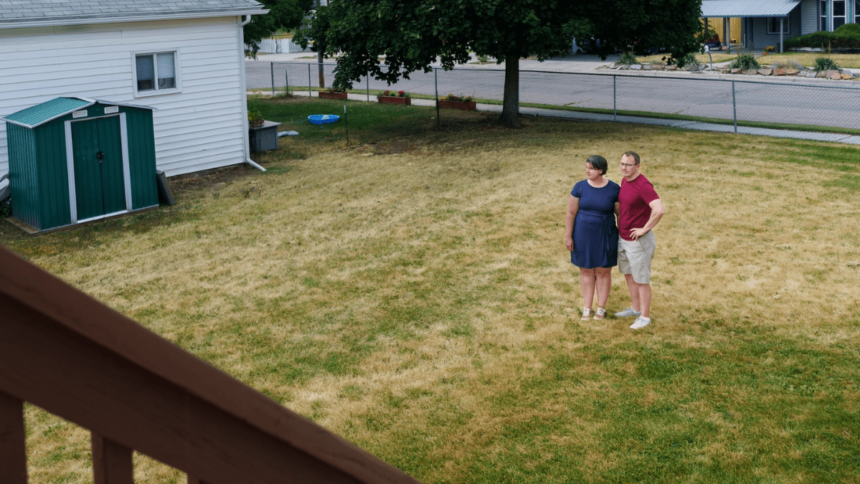This story was originally published by The Pulp at thepulp.org. It may not be republished without the express permission of The Pulp.
After the death of her mother in 2019, Nicole Rieker sold the family home in Billings and was left with a modest inheritance. Rieker and her husband, Drew, both accountants in Missoula, wanted to invest some of that money in rental houses. They looked at several places before settling on a parcel of three adjacent properties: two duplexes and a small, century-old house on a large corner lot on Cooley and Milton, in Missoula’s Northside neighborhood.
“They were the first places we walked in and said, ‘Yeah, we could live here,’” Nicole said. “We wanted places people could make their homes.”
The Riekers also saw opportunity in the size of the plots. The existing duplexes were built in the mid-1990s, and were inefficiently configured, but there was still plenty of space between them and wide setbacks from the road. It looked like the land could support more development.
“Of course, we’re uneducated and don’t know anything about zoning or development in Missoula,” Drew said, “but when you stand on this project, you go, ‘Dang, there’s a lot of opportunity here. There’s a lot of grass.’”
Nicole and Drew consulted with Hone Architects and Builders, who noted that if the land was bare, it could support 12 housing units. Nicole and Drew couldn’t imagine tearing down two perfectly good duplexes. It wouldn’t make financial sense to raze them and build from scratch, anyway. Instead, they imagined adding one more duplex and tearing down the decrepit house to build three new three-story townhomes. It would be a net gain of four housing units and, in theory, a win-win scenario for everyone. Nicole and Drew would be making a good investment better while adding generally affordable housing units to a city that desperately needs them.
Then came the reality check. The wide setback on the west side of the property? It was a mandatory utility easement on which nothing could be built. Adding a new duplex? That would change the classification of the land to multi-dwelling, requiring the addition of an accessible parking space to comply with the federal Fair Housing Act (though the buildings themselves wouldn’t have to be accessible), and an expensive civil engineer to adjust a boundary line by eight feet. That boundary line adjustment? It would require a subdivision exemption application, and while the city charges $400 for the application itself, the private costs of preparing one can easily exceed $10,000. It would also need a zoning compliance permit that could only be granted when the city had a complete design for the adjacent lot, where the century-old house sits. Normally, when multi-family housing is built next to single-family housing, a 5-foot buffer and fencing is required. The Riekers planned to offer one of the new duplex units to the current occupants of the old house, which would be torn down to build the townhomes. But those townhomes? One of them would need a driveway going out to Cooley Street, a detail rendered impossible when that street was recently designated a Neighborhood Greenway, a low-traffic street that the city controls for the comfort and safety of bikers and pedestrians. (Multiple driveways exit onto the street already.) Without enough space for three driveways exiting to the other street, the townhomes are infeasible. Now the Riekers don’t know what to do with the house, which was built in 1910 and Drew calls “a ticking time bomb.” Tearing it down to build a new one just doesn’t pencil, not when construction costs hover around $300 per square foot.
Meanwhile, Drew and Nicole are paying thousands of dollars in fees to architects and engineers, money they’ll hope to recover when it comes time to rent or sell what they build. Time is a factor, too. Both duplexes and the house have people in them now, and Nicole and Drew need to coordinate a building schedule around their tenants’ leases. They had hoped to break ground last year. Now they’ll be lucky to begin next May on the property’s only immediately viable development: the new duplex. Even that idea is encumbered with aggravating requirements; the city forester is insisting they plant trees between the duplex and the fence, a strip of land a few feet wide with so little sunlight it’s hard to imagine weeds growing, let alone trees.
Nicole and Drew Rieker. Credit: Coral Scoles-Coburn
“We had these plans, all these beautiful things,” Drew said. “Those dreams are really wavering now.”
“They’re afloat,” Nicole said. “Every time we turn around there’s something else, another delay or a problem with the boundary lines.”
As Drew scanned his head to take in all the empty space around him, he may as well have been taking in the housing crisis gripping the whole of Missoula. “With these rules,” he said, “something that looks abundant is absolutely not.”
It may sound like a problem for the privileged if a couple of landlords can’t build the new duplex and townhomes they want. But the story of developments like this and the rules that constrain them have a cumulative impact on the quantity of housing in Missoula, where new housing is built and how much all housing, old and new, will cost.
Right now, Missoula’s median monthly rent for individuals tops $1,000 and the median home price is $558,500. In 2022, the buyer of a median-priced home in Missoula County would need a household income of $156,564 to afford it without being cost-burdened. This is more than twice the median household income for that year, according to the 2024 Five Valleys Housing Report from the Missoula Organization of Realtors.
We all must love living here, because we do it despite the gray winters, the rising cost of living and the shortage of high-paying jobs. The question is, how many of us will be able to keep living here, as the cost of housing climbs faster than incomes?
Credit: Andy Kemmis
“All of the data tell us that it is possibly the hardest time in generations for a person starting out to own their own home,” said Grant Kier, CEO of Missoula Economic Partnership, which monitors the housing market for its crucial role in creating a vibrant, resilient local economy.
Missoula’s housing deficit goes back to the years following the Great Recession, Kier said, when the community fell 3,000 housing units behind its immediate needs. Adding to that deficit, the rate of new construction is not on pace with Missoula’s growth projections.
“If the community could do one thing, it would be more tolerant to changes to their built environment,” Kier said. “That will lead to changes in housing affordability that will allow more people to live here and will reduce accelerated rates of homelessness.”
It’s also important, Kier said, to build housing for all types of potential buyers. “People often think we aren’t helping address the housing affordability problem if we’re building some big, nice houses along the way,” he said. “That’s a misunderstanding of the market. If people can’t find the house they want to own, they’ll buy a much more affordable house and tear it down to build the house they want.”
Kier said that rules and ordinances, devised with the best of intentions, have compounded over the years to create a labyrinth of regulation that makes it challenging to build and stymies the very kind of growth Missoulians say they want. This realization has led the city of Missoula to embark on a lengthy code reform process, with newer, clearer and more consistent zoning rules promised early next year.
“The system is broken enough that it can’t be a small fix anymore,” Kier said. “We can’t just remodel. We have to take the whole house down.”
For anyone forecasting how Missoula will change as it grows, there’s no more important subject than city zoning regulations — that snoozer of a topic that is taking on an increasing role in shaping Missoula’s neighborhoods and community. In this context, the fate of each development, even a small-scale infill project on the Northside, incrementally affects all Missoula residents.
In much of the world, city planning is a haphazard affair. But for a generally rule-averse bunch, Americans abide by a considerable number of restrictions when it comes to where we can live and with whom, and what and how we can build on our land.
“The idea that a stodgy rule book could set the terms of our lives from on high is fundamentally at odds with our national ethos. And yet, such is the state of America under zoning,” Nolan Gray writes in “Arbitrary Lines: How Zoning Broke the American City and How to Fix It,” a book that argues our communities would be more equitable, affordable and sustainable if we completely overhauled zoning.





